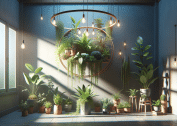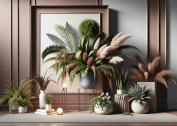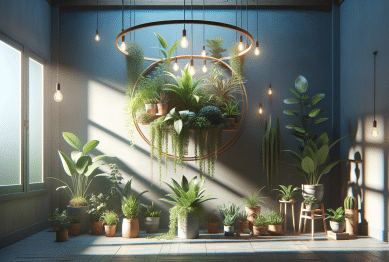Want to create a lush, healthy indoor garden that’s both beautiful and easy to care for? This guide reveals surprising strategies for growing a thriving indoor jungle using natural light, smart watering habits, and the best plant varieties to suit your space. Unlock tips to boost air quality, mood, and home style with greenery.
Choosing the Right Plants for Your Indoor Space
The foundation of a vibrant indoor garden begins with selecting plants that match your living environment. Bright rooms with large windows can support sun-loving species like fiddle leaf figs, succulents, and snake plants. For spaces with less natural light, options such as pothos, ZZ plants, and peace lilies can still thrive and add a lively touch to any corner. Matching plant needs to existing conditions often prevents disappointment and reduces maintenance.
It’s smart to consider the qualities of each plant you introduce into your home. Some indoor plants help purify air by neutralizing toxins. Classic varieties such as spider plants and Boston ferns are well known for their ability to freshen indoor environments while being relatively low-maintenance. These green friends can help transform stuffy air and may even lift your home’s overall mood.
If pets share your space, safety is a top priority. Many indoor plant owners discover that popular types—like lilies and dieffenbachia—are toxic to animals. To create a truly welcoming indoor jungle, look for pet-safe alternatives such as areca palm, parlor palm, and certain types of ferns. This careful planning brings peace of mind along with aesthetic appeal (Source: https://www.aspca.org/pet-care/animal-poison-control/toxic-and-non-toxic-plants).
Mastering Light, Water, and Humidity Indoors
Natural lighting is essential for healthy plant growth, but direct sun isn’t always best. Many popular houseplants prefer filtered light, which mimics the dappled sunshine of a forest understory. East-facing windows provide bright, indirect light ideal for most tropicals. If light is limited, consider using full-spectrum grow bulbs that deliver energy plants need for photosynthesis without raising temperatures in the home (Source: https://extension.psu.edu/lighting-indoor-houseplants).
Consistent watering routines support strong root systems, yet overwatering is a common mistake. Allowing the top inch of soil to dry—especially for succulents and cactus—reduces the risk of root rot. Grouping plants with similar water requirements helps you avoid over- or underwatering, saving both time and effort. A weekly check-in with your indoor jungle can reveal subtle signs of thirst or stress long before leaves yellow or drop.
Humidity often determines just how lush your plant collection grows. Dry indoor air in winter can slow growth or brown leaf tips. Placing a tray of water with pebbles beneath your pots or regularly misting foliage will raise humidity for tropical lovers like calatheas and orchids. Even simple habits like grouping plants together create a microclimate that boosts collective wellbeing. Small changes, big results.
Soil, Pots, and Fertilization: Key Details That Matter
Healthy indoor gardens rely on the right potting mix. Lightweight, well-draining soils prevent sogginess and support oxygen flow to roots. Cacti and succulents prefer a sandy blend, while foliage plants do well with peat-based potting soils. Take care to refresh or top up potting mix each year to avoid compacted, depleted earth that stifles growth (Source: https://gardeningsolutions.ifas.ufl.edu/plants/houseplants/general-care-for-houseplants.html).
Pots and planters aren’t just decorative—they directly impact root health. Choose containers with adequate drainage to avoid soggy soil, which can kill even the hardiest plants. Self-watering pots offer a hands-off approach for those with busy lifestyles, making it harder to overwater but still keeping moisture levels stable. Style and function work together when you pair the right container with each variety.
Fertilization keeps growth strong, but moderation is key. Use a diluted, balanced liquid fertilizer every four to six weeks during active growing periods. Leafy plants love a nitrogen boost, while flowering varieties benefit more from phosphorus. Too much fertilizer can burn roots and stunt development, so always follow label instructions closely. For those new to feeding routines, organic options are gentler and reduce the risk of mishaps while keeping plant care eco-friendly.
Pest Control and Plant Health Made Simple
Pests can creep into the indoor garden fast. Even a single aphid or spider mite might quickly multiply. Common culprits include whiteflies, scale insects, and fungus gnats. Early detection makes them easier to manage. Inspect leaves (especially the undersides) weekly. Look for sticky residue or tiny webs, which often signal unwanted guests. Removing pests by hand or using a gentle soap-and-water spray can prevent infestations before they spread (Source: https://www.rhs.org.uk/prevention-protection/plant-pests-diseases).
Natural pest control is preferred by many indoor gardeners. Neem oil spray keeps bugs at bay while being safe for use in homes with children and pets. Introducing beneficial insects, such as ladybugs, may work for persistent issues, especially in larger collections. Keep an eye out for signs of stressed plants—wilted leaves, stunted growth, or brown tips—since unhealthy plants are more susceptible to pest invasions than robust, thriving specimens.
Sometimes, plant diseases stem from excess moisture or poor airflow. Powdery mildew and root rot are two common concerns. Prevent these by spacing plants to encourage circulation and avoiding waterlogged soils. If a plant does fall ill, isolate it quickly and treat with appropriate fungicidal solutions. Pruning away damaged or infected leaves gives your indoor jungle the chance to recover naturally and resume healthy growth—without harmful chemicals.
Boosting Mood and Home Style with Greenery
Incorporating plants into your décor elevates much more than looks. Studies find that indoor greenery reduces stress and boosts focus. Simply viewing living plants may help sharpen concentration and improve feelings of wellbeing, making home offices or shared family spaces more enjoyable. Plants bring natural softness and dimension to modern interiors, contributing both calm and beauty (Source: https://www.ncbi.nlm.nih.gov/pmc/articles/PMC4419447/).
Design is personal, and plant placement can reflect your unique style. Hanging vines in macramé holders, displaying a row of succulents along a sunny shelf, or clustering potted ferns on the floor—these choices personalize spaces. Mixing leaf shapes and contrasting textures creates visual interest. Many people enjoy rotating plant displays seasonally, keeping the environment fresh and inviting year-round.
Beyond style, houseplants serve practical purposes. Larger specimens like rubber plants or weeping figs help filter air. Scented varieties, such as mint or lavender, add subtle fragrance to kitchens and bedrooms. In small apartments, trailing pothos or climbing philodendrons bring vertical life to bare walls, making even compact spaces feel vibrant, inviting, and alive.
Simple Strategies for Busy Lifestyles
Caring for an indoor jungle need not be time-consuming. Choose forgiving species such as snake plants, ZZ plants, and pothos—these adapt to irregular watering and variable light. Smart technology, like self-watering planters and programmable grow lights, can further simplify routines. This means lush greenery is possible, even if you travel often or have a hectic schedule.
Create routines tailored to your rhythm. A weekly check-in for watering, dusting leaves, and inspecting for pests goes far. Grouping plants by care level or function—such as all hard-to-kill types together near north-facing windows—takes guesswork out of maintenance. Labels or a digital calendar provide gentle reminders for busy urban gardeners.
Many people find that plant care itself offers relaxation. Taking a few minutes to tend greenery can become a calming ritual, reducing stress and promoting mindfulness after a long workday. In homes where every minute counts, these moments of connection with nature build small boosts of happiness along with a beautiful, thriving indoor jungle.
References
1. Penn State Extension. (n.d.). Lighting Indoor Houseplants. Retrieved from https://extension.psu.edu/lighting-indoor-houseplants
2. University of Florida IFAS Gardening Solutions. (n.d.). General Care for Houseplants. Retrieved from https://gardeningsolutions.ifas.ufl.edu/plants/houseplants/general-care-for-houseplants.html
3. Royal Horticultural Society. (n.d.). Prevention and Protection: Plant Pests and Diseases. Retrieved from https://www.rhs.org.uk/prevention-protection/plant-pests-diseases
4. NC State Extension. (n.d.). Plants for Cleaning Indoor Air. Retrieved from https://plants.ces.ncsu.edu/plants/category/air-cleaning/
5. National Institutes of Health. (2015). Interaction with indoor plants may reduce psychological and physiological stress by suppressing autonomic nervous system activity in young adults. Retrieved from https://www.ncbi.nlm.nih.gov/pmc/articles/PMC4419447/
6. ASPCA. (n.d.). Toxic and Non-Toxic Plants List. Retrieved from https://www.aspca.org/pet-care/animal-poison-control/toxic-and-non-toxic-plants









